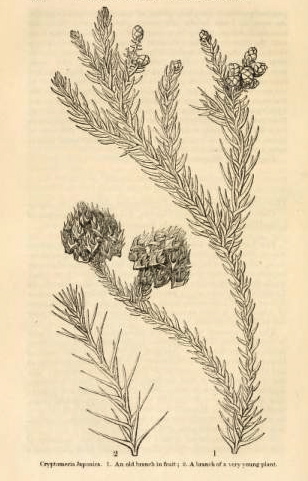
Cryptomeria, as described in 1838 by (Thunberg ex Linnaeus f.) David Don (1799-1841), in Annals of Natural History, 1st edition, is a monotypic genus of conifer in the cypress family (Cupressaceae), formerly infamily Taxodiaceae. It includes only one species, Cryptomeria japonica (synonymous with Cupressus japonica L.f.). It is endemic to Japan, where it is known as æ‰ (sugi) in the Japanese language. In China, it is known as ŠŠ‰Š±± (liu shan). The tree is often called Japanese cedar in English, even though the tree is not related to the true cedars (Cedrus). The name cyptomeria comes from the Greek language, translating as "hidden parts" referring to the manner in which the seeds are well hidden within the seed cones.
There are two recognized varieties:
Description. Japanese cedar is a very large evergreen coniferous tree, reaching up to 230 feet (70 m) tall with a 13 foot (4 m) wide trunk, measured at breast height.
This genus superficially similar to the related giant sequoia (Sequoiadendron giganteum), from which it can be differentiated by the longer leaves (less than 0.2 inch / 0.5 cm in the giant sequoia) and smaller cones (1.6 to 2.4 inches / 4 - 6 cm in the giant sequoia), and the harder bark on the trunk (thick, soft and spongy in giant sequoia).
Sugi has been so long-cultivated in China that it is thought by some to be native there. Forms selected for landscape and timber production long ago in China have been described as a distinct variety Cryptomeria japonica var. sinensis (or even a distinct species, Cryptomeria fortunei), but they do not differ from the full range of variation found in the wild in Japan, and there is no definite evidence the species ever occurred wild in China. Genetic analysis of the most famous Chinese population of Cryptomeria japonica var. sinensis in Tianmu Mountain, containing trees estimated to be nearly 1,000 years old, supports the hypothesis that the population originates from an introduction.
Cryptomeria grows in forests on deep, well-drained soils subject to warm, moist conditions, and it is fast-growing under these conditions. It is intolerant of poor soils and cold, drier climates.
Cryptomeria is used as a food plant by the larvae of some moths of the genus Endoclita including E. auratus, E. punctimargo and E. undulifer.
Sugi (and Hinoki) pollen is a major cause of hay fever in Japan.
C. japonica is extensively used in forestry plantations in Japan, China and the Azores islands, and is widely cultivated as an ornamental tree in other temperate areas, including Britain, Europe, North America and eastern Himalaya regions of Nepal and India. In the hills of Darjeeling and Sikkim (where it is called dhuppi) the tall trees yield a light, soft wood that is extensively used for making planking for houses.
The cultivar 'Elegans' is notable for retaining juvenile foliage throughout its life, instead of developing normal adult foliage when one year old (see the picture with different shoots). It makes a small, shrubby tree 15 to 30 feet (5 - 10 m) tall. There are numerous dwarf cultivars that are widely used in rock gardens and for bonsai, including 'Tansu', 'Koshyi', 'Little Diamond', 'Yokohama' and 'Kilmacurragh.'
The following cultivars have gained the Royal Horticultural Society's Award of Garden Merit: 'Bandai','Elegans Compacta','Globosa Nana' and 'Vilmoriniana'
The wood is scented, reddish-pink in color, lightweight but strong, waterproof and resistant to decay. It is favored in Japan for all types of construction work as well as interior paneling, etc. In Darjeeling district and Sikkim in India, where it is one of the most widely growing trees, Dhuppi (C. japonica ) is favoured for its light wood, extensively used in house building.
Its introduction in the Azores islands to be used commercially, resulted in the destruction of much of the original, now threatened, native laurel forest which affected an entire complex environment threatening many other species such as the priolo.
Sugi is the national tree of Japan, commonly planted around temples and shrines, with many hugely impressive trees planted centuries ago. In 1894 the Eminent American plantsman, Charles Sprague Sargent wrote in, The Forest Flora of Japan, the instance of a daimyŠ (feudal lord) who was too poor to donate a stone lantern at the funeral of the Shogun Tokugawa Ieyasu (1543-1616) at NikkŠ TŠshŠ-gŠ«, but requested instead to be allowed to plant an avenue of Sugi, "so that future visitors might be protected from the heat of the sun". The offer was accepted. The avenue, which still exists today, is over 40 miles (65 km) long, about which Sargent said in 1893 "has not its equal in stately grandeur."